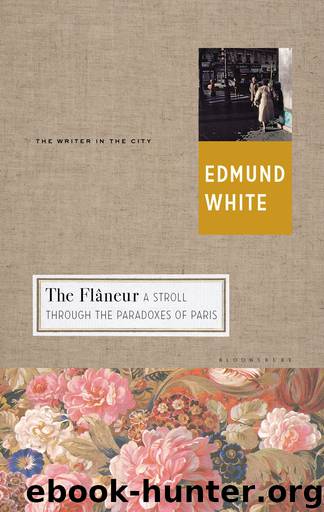The Flaneur by Edmund White

Author:Edmund White
Language: eng
Format: epub
Publisher: Bloomsbury Publishing
Published: 2015-06-01T16:00:00+00:00
The flâneur wanders to the Parc Monceau in the eighth arrondissement, just a stroll north and east of the Arc de Triomphe and the Champs-Elysées. Proust lived near here when he was growing up on the rue de Courcelles, at number 45; his neighbours included Camille Saint-Saëns (at 83 bis), the composer of Samson and Delilah, and Colette, who in 1896 moved with her first husband to number 93, where she conducted a salon amid her sleek Art Nouveau furnishings. Many of the great Jewish families also built houses on the Parc, which was a luxurious, landscaped site, replete with reflecting ponds, little hills and Greek temples; the Corinthian columns clustered around a pool are a leftover from an earlier eighteenth-century garden (the columns are known as the Naumachie).
Developed by a Jewish banker, Emile Pereire, after 1860, the modern park was surrounded by the sumptuous mansions of such Jewish millionaires as the Rothschilds, the Meniers and the Milanese financiers the Cernuschis; today the Cernuschi mansion houses a museum dedicated to their collection of Asian art. The founder of Zionism, Theodor Herzl, lived at number 8 rue de Monceau from 1891 to 1894.
The most impressive museum – and one that tells a melancholy tale – is the Musée Nissim de Camondo. It is located at 63 rue de Monceau and presents a sober, almost sombre façade to the street. Although it resembles the Petit Trianon at Versailles, it was built only in 1911. The owner, Moïse de Camondo, had torn down the family mansion (which had been put up in 1866), in order to construct this copy of an eighteenth-century town house – the ideal setting for his outstanding collection of furniture from the reigns of Louis XV and Louis XVI. Ironically, Camondo, whose own family would be entirely wiped out by the Holocaust, was attracted to the refined furniture, china, rugs and fabrics of an élite that itself was largely destroyed by its enemies.
Although this museum is little known, it houses a collection in its domain only slightly less impressive than those of the Frick Museum in New York and the Wallace in London. And because Camondo left behind instructions that every object must remain where he’d put it when he was living in the house, the whole has a unique lived–in feeling. None of the rooms is huge – which is appropriately in the spirit of the eighteenth century, an epoch that prized intimacy over grandeur, and comfort over magnificence.
The Camondos were a family of Jewish bankers who had been established in Constantinople for centuries but who were first mentioned in Ottoman records only towards the end of the eighteenth century. Temporarily in disfavour, the family fled the Ottoman Empire for Trieste in 1782. They prospered in Italy, where they were ennobled (King Victor Emmanuel II made them counts in 1867), but by the beginning of the nineteenth century some members of the family were back in Constantinople, where they founded a bank and acquired extensive real-estate holdings in Galata, the European quarter.
Download
This site does not store any files on its server. We only index and link to content provided by other sites. Please contact the content providers to delete copyright contents if any and email us, we'll remove relevant links or contents immediately.
How to Read Water: Clues and Patterns from Puddles to the Sea (Natural Navigation) by Tristan Gooley(2857)
Full Circle by Michael Palin(2772)
Into Thin Air by Jon Krakauer(2703)
How to Read Nature by Tristan Gooley(2666)
The Lost Art of Reading Nature's Signs by Tristan Gooley(2284)
In Patagonia by Bruce Chatwin(2271)
Don't Sleep, There Are Snakes by Daniel L. Everett(2217)
City of Djinns: a year in Delhi by William Dalrymple(2136)
L'Appart by David Lebovitz(2119)
The Songlines by Bruce Chatwin(2112)
Venice by Jan Morris(2051)
The Big Twitch by Sean Dooley(2044)
A Thousand Splendid Suns by Khaled Hosseini(1991)
Tokyo Geek's Guide: Manga, Anime, Gaming, Cosplay, Toys, Idols & More - The Ultimate Guide to Japan's Otaku Culture by Simone Gianni(1947)
A TIME OF GIFTS by Patrick Leigh Fermor(1849)
Come, Tell Me How You Live by Mallowan Agatha Christie(1768)
The Queen of Nothing by Holly Black(1754)
INTO THE WILD by Jon Krakauer(1724)
Iranian Rappers And Persian Porn by Maslin Jamie(1710)
